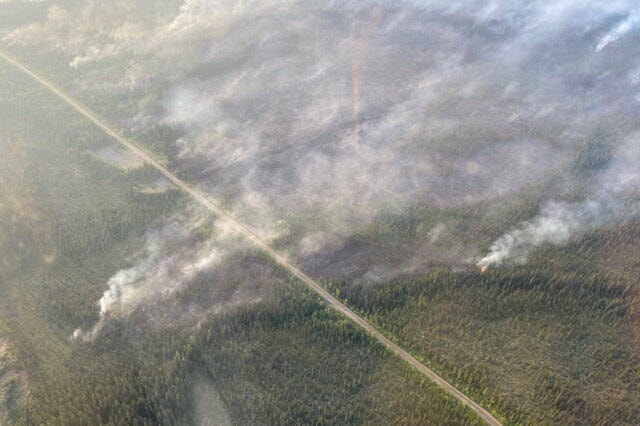A dozen new lightning-caused fires discovered on June 29 and 30 have prompted the Yukon government to restrict the use of fires in the territory.
“Personal fire use is being restricted because there is extreme fire danger,” says a news release issued June 30.
As of noon on June 30, a Level 2 fire ban will be in place, meaning that cooking and warming fires will only be allowed in the provided pits and stoves at road accessible territorial and commercial campgrounds. The ban will be in place in all fire-management districts until further notice.
Fire information officer Haley Ritchie said none of the new fires are human-caused but with hot, dry weather and thunderstorms leaving new fires in their wake, Wildland Fire Management’s crews and resources are already busy. The burn ban notice states that additional human caused fires could compromise firefighters’ current efforts.
The 12 new fires spotted over the past 24 hours bring the total number of fires observed this season up to 51. Thirty-eight of those fires are currently active.
Ritchie said most of the fires are in the Ross River region but other new ones are north of Faro and in the Carmacks area. She added that most of the new fires are being assessed or targeted with water tankers.
Among the significant fires burning in the territory are the Rock Island Lake fire and the Finlayson Lake fire.
The Rock Island Lake burn is 186 hectares in size and about 18 kilometres north of Minto. Ritchie said it is not a threat to Minto itself. A crew of 34 firefighters assisted by three helicopters and some overnight rain slowed the fire’s growth.
“We have a lot of resources there. And if that fire gets mopped up and under control, we’ll be able to move those resources to some of the other fires in that area,” Ritchie said.
The Finlayson Lake fire, presently approximately 190 acres, temporarily closed the Robert Campbell Highway after burning across it. Ritchie said the highway has since reopened to traffic in the evenings. Wildland fire was continuing to respond to it June 30.
The North Canol Road is also closed between kilometres 282 and 344 due to another fire.
Ritchie said wildland firefighters are working to protect any cabins or camps near the fires. None of the fires are near communities.
She added that Yukon crews are being assisted by some firefighters from British Columbia who will be staying through the long weekend.
Environment Canada has issued special weather statements warning of wildfire smoke and the potential for above seasonal temperatures. It is in effect for Beaver Creek, Dawson, the Dempster Highway, the Faro and Ross River area, Mayo, Old Crow and the Pelly and Carmacks region.
The public are being asked to report any smoke or other evidence of wildfires that they see to 1-888-798-FIRE (3473).
According to the press release from Wildland Fire Management, Level 2 is the middle tier of the territory’s fire ban system.
“Under extreme conditions, fires can start easily, spread rapidly and challenge fire response efforts,” it said.
Contact Jim Elliot at jim.elliot@yukon-news.com
